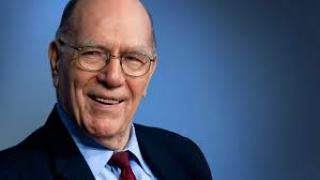Feb. 19, 2025 (EIRNS)—The dizzying pace of developments on the world stage over the last 30 days has left most of the world—including many of the principal actors in these events—at a loss to explain what is happening, and why things are moving so rapidly.
In the last week alone, the entire post-war geopolitical order has begun to crumble. The U.S. and Russia have resumed the path of rational discussion among equals, bringing the prospect of an end to the Ukraine-Russia into focus as well as sharply reducing the danger of imminent thermonuclear war. The European establishment was shocked to the point of tears by Vice President J.D. Vance’s honest characterization of their anti-democratic policies and irrelevance to solve the current crisis. A desperate and dissociated Volodymyr Zelenskyy chose to attack President Trump publicly for not inviting him to the U.S.-Russia meeting in Riyadh, charging that Trump “lives in this disinformation space” created by Russia. Trump replied that Zelenskyy is “a Dictator without Elections,” whereas his administration is “successfully negotiating an end to the War with Russia.”
Vice President J.D. Vance also responded: “Zelenskyy is getting really bad advice, and I don’t know from whom.” He added pointedly: “This is not a good way to deal with President Trump.”
Vance may well know the answer to his own rhetorical question. The provocative policy response demanding a continuation of the war—and of the entire geopolitical Old Order—is coming from Imperial London, as it has throughout the Ukraine war. President Trump and his advisers should take the opportunity to sever the entire Churchillian “special relationship” between the U.K. and the U.S.—emphatically including the “Five Eyes” intelligence cohabitation which was behind the efforts to jail, or kill, Trump—while they still have them on the back foot.
But how to create a New Paradigm as the old order comes crashing down? What about the ongoing genocide in Gaza and the broader crisis in Southwest Asia? How to reorganize the global financial system, with its $2 quadrillion of speculative cancer? As with all such phase-changes, the solutions aren’t arbitrary: There is only one way the jigsaw puzzle fits together.
We turn to Lyndon LaRouche to understand the nature of the problem, and its solution. In his 1999 Presidential campaign book, The Road to Recovery, LaRouche raised the question: “What are phase-changes?”
“The simplest analogy for what I signify by ‘phase-changes,’ is the transition from ice to water, or water to steam, or steam to a plasma state. That is to emphasize, that although the chemical composition of the material remains ostensibly unchanged, the physical behavior of the system, including its interaction with other systems, has been qualitatively altered…. In the kinds of political, economic, social, and psychological shock which most of you have already begun to experience in your immediate environment, we are dealing with a different quality of phase-changes than those identified by the series of examples I have referenced above. Despite that difference, the political changes we are addressing now, are still phase-changes….
“The effects usually become obvious to ordinary observers, as now, only in those periods of turbulent transition, which mark the passage of human affairs from one state of society in general, through a turbulent time of birth-pangs, leading to the birth, or the still-birth, of a qualitatively new state of affairs in general….
“The time for simple dreams is past. Tectonic upheavals are now the normal state of affairs…. It is this fundamental change in the character of the way the world works, which now determines the changing shape of world events.”
How, then, are we to design and bring about the needed change under today’s conditions of systemic crisis?
“Such needed, sweeping phase-shifts in policy-structures,” LaRouche advised in a July 2002 policy statement, “can be implemented democratically only under conditions of perceived crisis, during which popular attachment to previously embedded, but failed policy-matrices is seriously undermined. The early phase of social effects corresponding to general collapse of a bankrupt system of policies and related practices, is, unfortunately, usually a relatively brief interval during which appropriate systemic policy-changes can be implemented, as during the ‘first ninety days’ of FDR’s first administration. Only what might be described as ‘dramatic’ changes in policy-matrices, can pull a nation out of the systemic collapse which a continuation of presently accepted political doctrines ensures.”
To discuss—and learn how to design—those needed new policy-matrices, join the weekly dialogue led by the Schiller Institute’s Helga Zepp-LaRouche at the meetings of the International Policy Coalition. And plan to attend upcoming Schiller Institute in-person conferences, to discover how to provide answers for Mankind in these times of turbulence.






